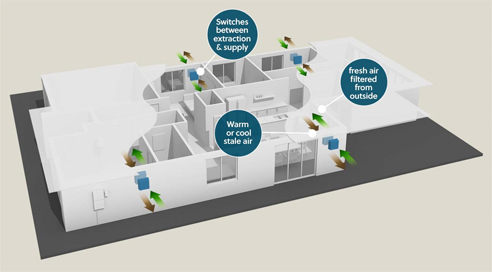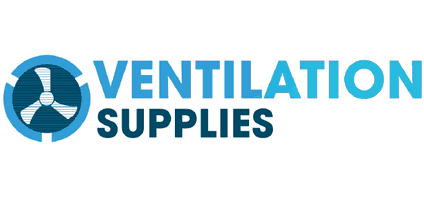Heat Recovery Ventilation from Homevent In today's day and age, modern houses are generally sealed and the air is laden with moisture and pollutants. The moisture & pollutants are created from the daily activities of the occupants of the house. The installation of an air exchanger inside the house will remove stale and polluted air from the house to the outside and replace it by an equivalence of fresh air. Generally, an air exchanger system installed properly will renew the air of all the important parts of the house. How does this happen? Through a ductwork system installed in the walls; those ducts ending with fresh air distribution grilles and stale air exhaust grilles. Fresh air distribution grilles are located in each room of the house needing fresh air (which are, among others, bedrooms, kitchen and living room). The stale air to outside grilles are generally located at the highest level of the house, where the excess humidity and pollutants build-up. The fresh air distribution and stale air exhaust ducts are connected to the air exchanger. Two other ducts are also connected to the unit: one for gathering fresh air from outside and the other one to exhaust the stale air to outside. The air exchanger manages the ventilation for the whole house. What Heat Recovery Ventilation (HRV) is used for Ventilation through open windows is not always ideal, especially during the colder months when you are trying to keep your premises warm. The use of an energy efficient ventilation system with heat recovery will help to maintain a fresh ambiance and help to recover up to 90% of the warmth created inside. With an ever increasing demand for building air tightness for improved energy efficiency, effective ventilation is also necessary for improving indoor air quality and the protection of building structures from fungal growth.
|
1300 577 777 Unit 26, Dural Park, 280 New Line Road, Dural, NSW, 2158
|





 Ventilate to Prevent Surface
Ventilate to Prevent Surface Home Ventilation & Mould Removal
Home Ventilation & Mould Removal Residential Damp Prevention &
Residential Damp Prevention & Energy Efficient Ventilation Systems for
Energy Efficient Ventilation Systems for Residential Ventilation Systems Sydney
Residential Ventilation Systems Sydney High-Quality Exhaust Fans Online from
High-Quality Exhaust Fans Online from Sub Floor Ventilation from Ventilation
Sub Floor Ventilation from Ventilation The LT-50 Heat Recovery Vent from
The LT-50 Heat Recovery Vent from Heat Recovery with Room Ventilation from
Heat Recovery with Room Ventilation from Whirl3 Solar Powered Roof Fan from
Whirl3 Solar Powered Roof Fan from Solar Roof Ventilation from Ventilation
Solar Roof Ventilation from Ventilation Toilet Roof Fans from Ventilation
Toilet Roof Fans from Ventilation Kitchen Ventilation from Ventilation
Kitchen Ventilation from Ventilation Bathroom Ventilation | Ventilation
Bathroom Ventilation | Ventilation Mould Inspection & Removal |
Mould Inspection & Removal | In-Home Health Assessments | Homevent
In-Home Health Assessments | Homevent Pre-Purchase Inspections Sydney |
Pre-Purchase Inspections Sydney | Air Purification Treatments | Homevent
Air Purification Treatments | Homevent Mould Cleaning & Prevention |
Mould Cleaning & Prevention | Air-Conditioning Servicing Sydney |
Air-Conditioning Servicing Sydney |
